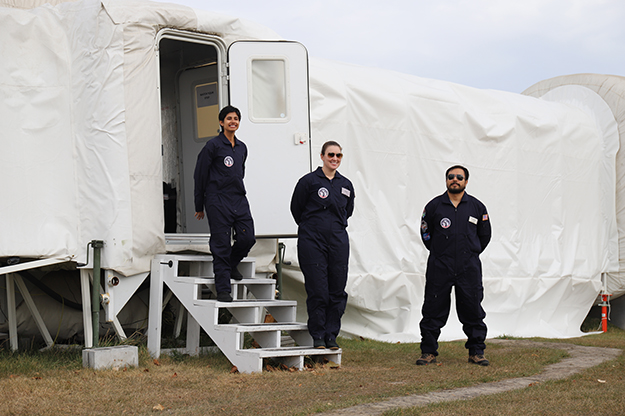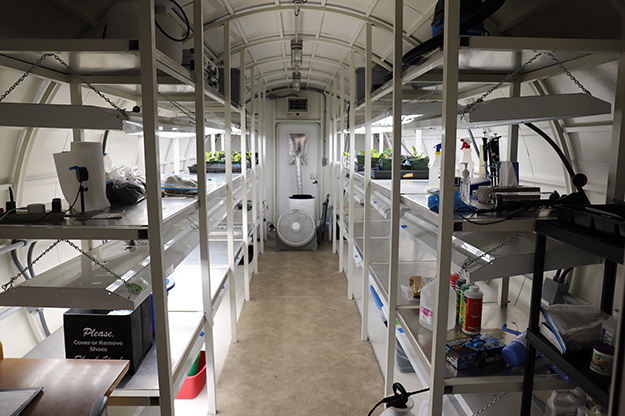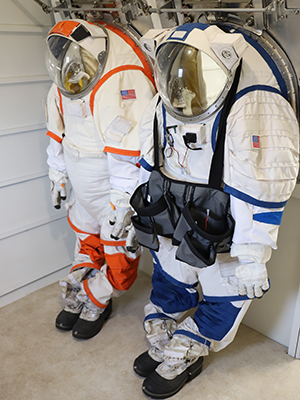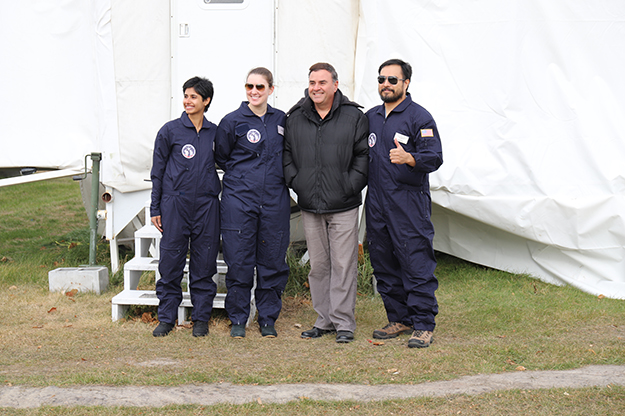Down to Earth
UND ‘astronauts’ emerge from 14-day simulated mission to Mars in good spirits

Lauren Banken looked like a kid in a candy store — on Mars.
As she exited UND’s first-of-its-kind extraterrestrial home base — the Inflatable Mars/Lunar Habitat (IMLH) — she wore the same beaming grin that she had when she entered it 14 days earlier.
Banken, a graduate student in UND’s Space Studies Department, and two other crew members, Anamika (who goes by last name only), another grad student, and Dr. Michael Castro, spent the past fortnight, mostly inside the habitat, conducting important research for NASA and other science agencies in preparation for future missions to the moon, Mars and beyond.
They finally emerged from their temporary home, located on an open field just west of the UND campus, at precisely 11:45 a.m. Wednesday. Everything during the mission– the sixth at UND — was fashioned to simulate, as closely as possible, life on the moon or Mars.
On occasions when the crew left the IMLH, they had to wear spacesuits specially designed for NASA at UND.
“I always thought of myself wanting to be an astronaut as a kid,” said Banken, taking her first breaths of outdoors earthly oxygen in a couple weeks. “This might be the closest experience that I’m ever going to get, but the data that we are collecting here might actually help astronauts at some point in the future.”

Work that’s fun
Inside the IMHL, the crew members conducted research on plants to see if they could simulate production of edible foods from “Martian dirt” to sustain human life. They also studied themselves: recording their body functions and brainwaves during their long stint in isolation.
NASA also wanted the crew to perform specific tasks, known as Extra Vehicular Activities (EVA), while wearing the spacesuits in settings outside of the cozy-warm IMLH. This entailed getting into a specially modified Mars/Lunar rover and tooling about the west side of campus.
“The EVAs were the highlight,” said Banken, a native of Duluth, Minn. “Everyone really looks forward to getting in the spacesuits and finally feeling like an astronaut.”
In total, the crew performed 28 experiments.
Anamika, who grew up in Jaipur, India, said the motivation usually begins as a dream of becoming an astronaut.
“The research that we do here will help a lot of people prepare for long-term missions in space some day,” Anamika said.
So it’s not all fun and games?
“It was all fun,” quipped Castro, a veteran of two IMLH missions from Palm Bay, Fla.
“We were doing work that was fun,” Anamika added, with a smile.
“We had a great time,” Banken followed up. “We had excellent teamwork throughout the mission, which was super critical to the successes we had.”

Similar environments
The IMLH is largely the product of Pablo de León, UND space engineer and professor of space studies. It evolved from work he pioneered years ago on new generations of spacesuits for NASA. Conversations eventually turned from spacesuits and merely surviving in space to thriving long term on other planets.
The similarity in materials used in de León’s spacesuits and what would be needed to design extraterrestrial habitats did not go unnoticed by NASA and the scientific community. So, de León and his UND teams wrote up grant requests and started securing funds to build homes designed for Earthlings to live and work on other celestial bodies.
There’s a lot to think about when creating something meant to withstand the wide-ranging elements of a place like Mars. The average daily temperature on the Red Planet can range from -243 degrees Fahrenheit at the poles to a relatively balmy 70 degrees at noon on the equator.
“Of course, North Dakota, right now, doesn’t look much like outer space because everything is still a bit green,” de León said, “but in the middle of the winter, we can simulate some things because North Dakota — in winter — is very similar to the temperatures on Mars.
“We are the only University that is doing this type of research,” he added.

Longer missions
The habitat has grown over the years from one section, when current UND Space Studies instructor Travis Nelson was a student and served as mission commander for the first-ever IMLH mission. Today, after six missions, it comprises five sections, including spaces for botanical and human factors research, an exercise room and teched up living quarters — with most of the comforts of home.
The newest addition will host geological research.
Nelson, who now serves as a mission controller for each of the IMLH missions, says preparations will take place over the winter months for IMLH mission No. 7. And with the IMLH fully operational with five modules, they’ll likely add another crew member to the mix and extend the the mission duration to 30-45 days.
“We’re definitely on board with longer missions,” he said. “Each mission is a stepping stone from the first one in that we are providing more realistic scenarios, like they have on the moon or Mars, and improving the simulation aspect every time.”
De León says it’s his students who are benefiting the most right now.
“It’s a great experience for them and and it’s very hands on training that we provide,” de León said. “I always say that even before they get their diplomas, they are getting picked up by aerospace companies all over the United States.”


